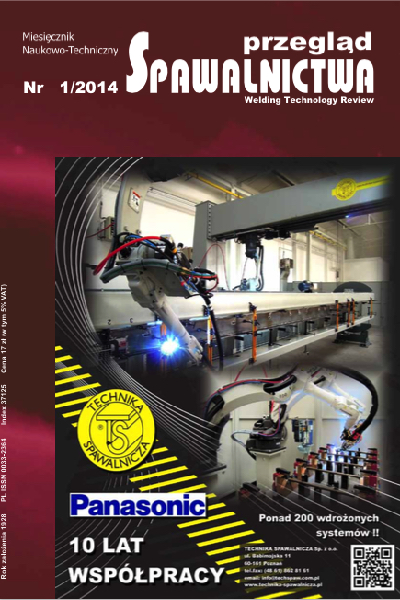Funkcjonalność i efektywność ekonomiczna zrobotyzowanego ukosowania blach
Main Article Content
Abstract
Od połowy lat 90. XX w. PIAP wdrożył w zakładzie TAGOR S.A. w Tarnowskich Górach cztery zrobotyzowane stanowiska ukosowania blach. W pierwszym z nich zastosowano robota na torze jezdnym i cięcie tlenowe. W kolejnych wykorzystano roboty stacjonarne oraz cięcie tlenowe i plazmowe. Typ zastosowanego robota oraz organizacja gniazda determinują jego przydatność do obróbki detali o określonych gabarytach. Z kolei technologia cięcia wpływa na efektywność procesu. Wybór technologii wiąże się również z konkretnymi zagrożeniami bezpieczeństwa pracy, co ma także przełożenie na koszty. W artykule zostanie podjęta próba syntetycznej oceny różnych rozwiązań pod kątem ich zastosowania do określonego profilu produkcji. Wykorzystane zostaną doświadczenia zakładu.
Functionality and economic efficiency of the robotic plate bevel
Absô°€ô°‚tract
Since the mid-90s PIAP has implemented four robotic cells for metal sheets bevelling at the plant TAGOR SA in Tarnowskie Gory. The first one have used the robot on the track and oxygen cutting. In the next stationary robots as well as oxygene and plasma cutting were used. The type of the robot and the organization of cells determine the suitability of the whole installation for processing of workpieces of a particular size. Then the cutting technology affects the efficiency of the process. The choice of technology is also associated with specific safety hazards, which in effect influence the cost the production process. This article will attempt to synthetic evaluation of different solutions in terms of their application to a specific production profile. Experience of the plant will be used.
Downloads
Article Details
Creative Commons CC BY 4.0 https://creativecommons.org/licenses/by/4.0/
Welding Technology Review (WTR) articles are published open access under a CC BY licence (Creative Commons Attribution 4.0 International licence). The CC BY licence is the most open licence available and considered the industry 'gold standard' for open access; it is also preferred by many funders. This licence allows readers to copy and redistribute the material in any medium or format, and to alter, transform, or build upon the material, including for commercial use, providing the original author is credited.
References
Poltowicz K.: Technologie cięcia termicznego i hydroabrazyw-nego, Projektowanie i Konstrukcje Inżynierskie, 10/2010.
Urządzenie do cięcia plazmą FineFocus800, Instrukcja obsługi, Kjellberg Finsterwalde http://www.kjellberg.de.
Hypertherm, urządzenia do cięcia plazmowego http://www.hypertherm.com.
Messer urządzenia do cięcia gazowego, http://www.messercw.de
Pilat Z.: Robotyzacja cięcia i ukosowania blach 15 lat doświadczeń. Przegląd Spawalnictwa 6/2010.
Pilat Z.: Different Solution of Robotic Cells for Metal Sheets Beveling. Applied Mechanics and Materials Vol. 282 (2013) s. 66÷73, © (2013) Trans Tech Publications, Switzerland.
World Robotics 2011 Industrial Robots, International Federation for Robotics (IFR), VDMA, Frankfurt Germany, 2010.
Hylla R. Pilat Z.: Zrobotyzowane stanowisko ukosowania
blach metodą cięcia plazmowego. Pomiary, Automatyka, Robotyka nr 10/2010, s. 22÷27.
